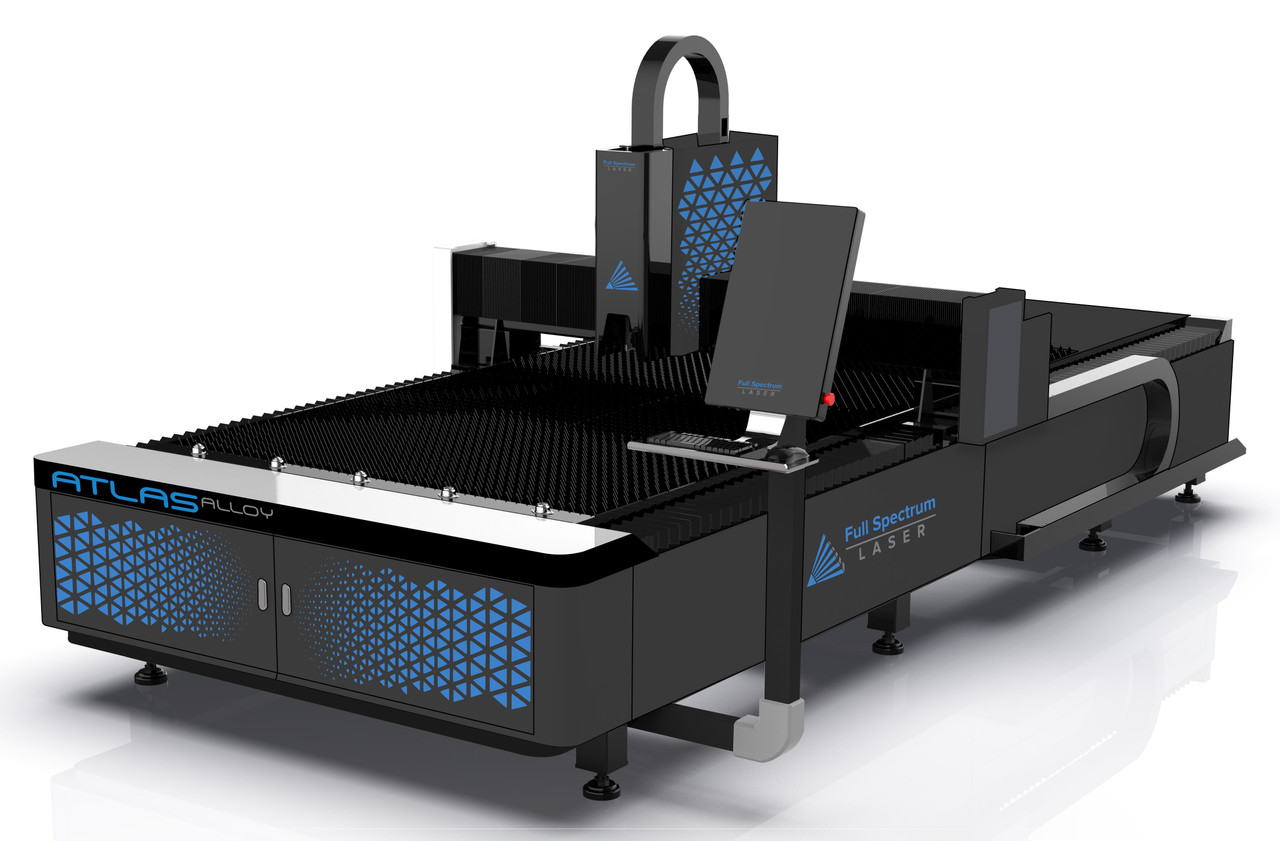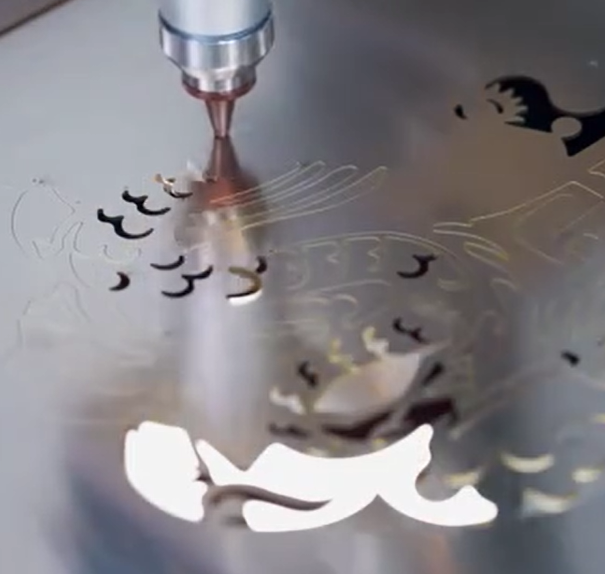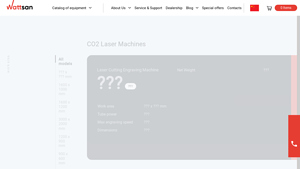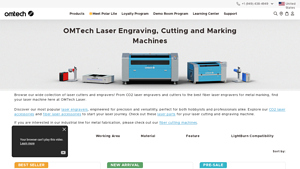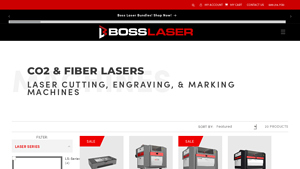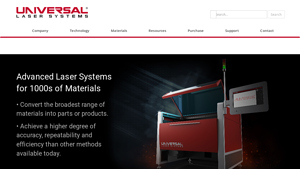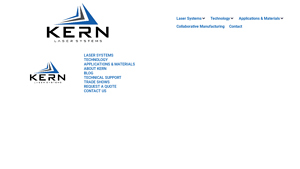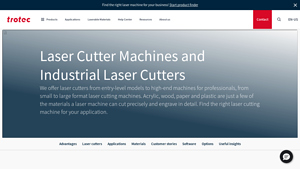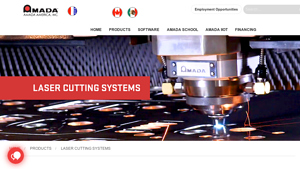Laser Cutting System Guide: Type, Cost, Top List…
Introduction: Navigating the Global Market for laser cutting system
In today’s competitive landscape, sourcing the right laser cutting system can present a formidable challenge for international B2B buyers. With diverse applications ranging from intricate engravings to heavy-duty metal cutting, understanding the nuances of various laser technologies is crucial. This guide delves into the global market for laser cutting systems, providing valuable insights into different types of machines, their applications, and the critical factors to consider when making a purchase.
As buyers from regions such as Africa, South America, the Middle East, and Europe—including key markets like Brazil and Germany—navigate the complexities of this industry, this comprehensive resource is designed to empower informed purchasing decisions. We will explore essential aspects such as supplier vetting processes, cost considerations, and the latest technological advancements in laser cutting systems. By leveraging this guide, B2B buyers will be equipped to assess their specific needs, compare options effectively, and ultimately select a system that aligns with their operational goals.
The laser cutting market is dynamic, influenced by evolving technologies and changing customer demands. Understanding these trends will not only aid in making strategic investments but also enhance operational efficiency and product quality. Whether you are looking to expand your manufacturing capabilities or seeking innovative solutions for your production line, this guide serves as your essential tool for navigating the global market for laser cutting systems.
Understanding laser cutting system Types and Variations
| Type Name | Key Distinguishing Features | Primary B2B Applications | Brief Pros & Cons for Buyers |
|---|---|---|---|
| CO2 Laser Cutting System | Utilizes CO2 gas for cutting; ideal for non-metal materials | Woodworking, textiles, acrylic, and plastics | Pros: Cost-effective, versatile for various materials; Cons: Limited metal cutting capabilities. |
| Fiber Laser Cutting System | Uses fiber optics for high-energy beams; efficient for metals | Metal fabrication, automotive, aerospace | Pros: High precision, faster cutting speeds; Cons: Higher initial investment. |
| MOPA Laser Cutting System | Offers adjustable pulse duration; suitable for marking and cutting | Electronics, jewelry, and thin metals | Pros: Versatile for both engraving and cutting; Cons: More complex operation and maintenance. |
| UV Laser Cutting System | Employs UV light for precision cutting; minimal heat affected zone | Medical devices, electronics, and fine materials | Pros: High precision, minimal thermal distortion; Cons: Higher cost and specialized applications. |
| Hybrid Laser Cutting System | Combines different laser technologies for enhanced capabilities | Diverse industries including packaging and signage | Pros: Versatile, capable of processing a wider range of materials; Cons: Complexity in setup and operation. |
What Are the Key Characteristics of CO2 Laser Cutting Systems?
CO2 laser cutting systems are widely recognized for their effectiveness in cutting and engraving non-metal materials such as wood, acrylic, and textiles. These systems utilize CO2 gas to generate a focused laser beam, making them highly effective for applications in woodworking and signage. When considering a CO2 laser system, buyers should evaluate the machine’s power, work area size, and engraving speed to ensure it meets their production needs. Cost-effectiveness makes these systems attractive for businesses just starting in laser cutting.
How Do Fiber Laser Cutting Systems Stand Out?
Fiber laser cutting systems are distinguished by their use of fiber optics to produce a concentrated beam of light, making them particularly effective for cutting metals. Industries such as automotive and aerospace benefit from the high precision and speed these systems offer. Buyers should consider factors such as wattage and cutting thickness when selecting a fiber laser cutter, as these elements directly impact operational efficiency and material compatibility. While the initial investment may be higher, the long-term benefits in productivity can justify the cost.
Why Choose MOPA Laser Cutting Systems?
MOPA (Master Oscillator Power Amplifier) laser cutting systems are notable for their adjustable pulse durations, allowing for both engraving and cutting applications. They are particularly effective for thin metals and detailed markings, making them suitable for industries like electronics and jewelry. When purchasing a MOPA laser system, businesses should assess the machine’s versatility and ease of use, as well as its maintenance requirements. This system represents a balance of advanced technology and functionality, appealing to B2B buyers looking for precision.
What Advantages Do UV Laser Cutting Systems Offer?
UV laser cutting systems operate using ultraviolet light, which allows for extremely precise cutting with minimal heat impact on surrounding materials. This technology is especially beneficial in fields such as medical device manufacturing and electronics, where precision is paramount. Buyers should consider the specific applications of a UV laser system, as well as its cost and maintenance needs. While these systems may come at a higher price point, their ability to produce high-quality cuts can lead to significant long-term savings in material waste and rework.
How Do Hybrid Laser Cutting Systems Enhance Capabilities?
Hybrid laser cutting systems combine different laser technologies to optimize performance across a range of materials. This versatility makes them suitable for various applications, including packaging and signage. When exploring hybrid systems, buyers should evaluate the specific technologies integrated into the machine and their compatibility with intended materials. Although hybrid systems may require more complex setups and training, their adaptability can provide businesses with a competitive edge in diverse markets.
Key Industrial Applications of laser cutting system
| Industry/Sector | Specific Application of Laser Cutting System | Value/Benefit for the Business | Key Sourcing Considerations for this Application |
|---|---|---|---|
| Automotive Manufacturing | Cutting and engraving metal components | High precision and reduced material wastage | Machine power, speed, and compatibility with metal types |
| Aerospace | Fabrication of lightweight structural parts | Enhanced design flexibility and weight reduction | Certification standards, precision requirements, and reliability |
| Textile and Fashion | Cutting fabrics and leather for garments | Fast production cycles and intricate designs | Material compatibility, machine size, and engraving features |
| Electronics | PCB and electronic component manufacturing | Precision cutting for intricate designs | Laser type (CO2 vs. fiber), power requirements, and software integration |
| Signage and Branding | Custom sign creation and promotional materials | High-quality finishes and customization options | Size specifications, engraving capabilities, and speed requirements |
How is Laser Cutting Used in Automotive Manufacturing?
In the automotive sector, laser cutting systems are employed to cut and engrave metal components with high precision. This technology allows for the efficient production of intricate parts, reducing material wastage and ensuring tight tolerances essential for vehicle safety and performance. International buyers should consider the power and speed of the laser cutter, as well as its compatibility with different metal types, to ensure it meets production needs effectively.
What Role Does Laser Cutting Play in Aerospace Applications?
Laser cutting systems are critical in aerospace for fabricating lightweight structural parts. The ability to create complex geometries while maintaining strength is vital in aircraft design. This technology not only enhances design flexibility but also contributes to significant weight reduction, improving fuel efficiency. Buyers must focus on certification standards, precision requirements, and the reliability of the laser systems when sourcing equipment for aerospace applications.
How is Laser Cutting Beneficial for Textile and Fashion Industries?
In the textile and fashion industry, laser cutting is utilized for cutting fabrics and leather, enabling fast production cycles while allowing for intricate designs that traditional methods cannot achieve. This technology enhances creativity and customization in garment production, appealing to modern consumer demands. Buyers should ensure that the laser cutting system is compatible with various materials, offers the right machine size for their production scale, and includes engraving features for added value.
Why is Laser Cutting Essential for Electronics Manufacturing?
For electronics manufacturing, laser cutting systems are essential for producing printed circuit boards (PCBs) and other intricate electronic components. The precision of laser cutting ensures that even the smallest features are accurately created, which is critical for functionality and reliability. When sourcing laser systems for this sector, buyers need to consider the type of laser (CO2 vs. fiber), power requirements, and how well the machine integrates with existing software for design and production processes.
How Does Laser Cutting Enhance Signage and Branding Solutions?
Laser cutting systems are extensively used in the signage and branding industry to create custom signs and promotional materials. This technology provides high-quality finishes and a range of customization options, allowing businesses to stand out in competitive markets. Buyers should focus on size specifications, the engraving capabilities of the machines, and the speed of production to meet the demands of their clients effectively.
3 Common User Pain Points for ‘laser cutting system’ & Their Solutions
Scenario 1: Difficulty in Material Compatibility for Laser Cutting Systems
The Problem: B2B buyers often struggle with selecting the right laser cutting system that can handle a diverse range of materials. For instance, a manufacturer may need to cut both metal and acrylic, but not all laser systems are equipped to handle both effectively. This leads to potential downtime as the buyer faces challenges in sourcing different machines for different materials, resulting in increased operational costs and project delays.
The Solution: When sourcing a laser cutting system, buyers should prioritize machines with versatile capabilities. Look for systems that specify compatibility with a range of materials—such as CO2 lasers for non-metal materials like wood and acrylic, and fiber lasers for metals. Engaging with suppliers who offer customizable solutions can also be beneficial; they can help you tailor your machine configuration to meet specific material requirements. Additionally, consider investing in a laser cutting system with adjustable power settings and focal lengths, which can enhance the machine’s ability to process various materials effectively. This strategic approach not only streamlines operations but also reduces the need for multiple machines, thus lowering overall costs.
Scenario 2: High Operational Costs Due to Inefficiency
The Problem: Another significant pain point for B2B buyers is the high operational costs associated with inefficient laser cutting systems. Many businesses may find that their current machines are not energy-efficient or require excessive maintenance, leading to higher electricity bills and increased downtime for repairs. This inefficiency can severely impact profit margins, particularly for companies operating in highly competitive markets.
The Solution: To mitigate these costs, buyers should conduct thorough research and choose laser cutting systems that are known for their energy efficiency and low maintenance requirements. Look for features like advanced cooling systems that reduce energy consumption and innovative software that optimizes cutting paths to minimize waste. Additionally, consider models that offer predictive maintenance features, which can alert you before issues arise, reducing unexpected downtime. Investing in a high-quality, energy-efficient laser cutting system may have a higher upfront cost, but the long-term savings on operational expenses can significantly outweigh this initial investment, ultimately enhancing your bottom line.
Scenario 3: Complexity in Machine Operation and Training
The Problem: Many B2B buyers face challenges related to the complexity of operating laser cutting systems, especially when introducing new technology into their workflows. Employees may struggle to learn how to operate the machine effectively, leading to inefficient production processes and a steep learning curve. This can be particularly problematic in regions where skilled labor is scarce or where there is a high turnover rate among staff.
The Solution: To address this issue, it is crucial to choose laser cutting systems that come with user-friendly interfaces and comprehensive training programs. Look for suppliers that offer extensive training sessions and ongoing support to ensure that your team can operate the machine efficiently. Additionally, consider systems that provide intuitive software with built-in tutorials or easy-to-navigate controls. Implementing a mentorship program within your organization, where experienced staff can guide new users, can also facilitate smoother transitions and enhance overall productivity. By investing in both the right technology and the necessary training, companies can significantly reduce operational complexities and improve employee confidence in using laser cutting systems.
Strategic Material Selection Guide for laser cutting system
What Are the Key Properties of Common Materials Used in Laser Cutting Systems?
When selecting materials for laser cutting systems, it’s essential to understand their properties and how they influence performance. The most commonly used materials include acrylic, wood, metal, and fabric. Each material has unique characteristics that affect its suitability for various applications.
Acrylic: What Makes It a Popular Choice for Laser Cutting?
Acrylic is a versatile plastic known for its clarity and ability to mimic glass. It has a low melting point, making it easy to cut and engrave with laser systems. Key properties include high impact resistance and good weatherability, which contribute to its durability in outdoor applications.
Pros: Acrylic is lightweight, easy to fabricate, and available in various colors. It also provides a smooth finish, enhancing aesthetic appeal.
Cons: However, acrylic can be prone to scratching and may not withstand high temperatures, limiting its use in certain environments.
For international buyers, compliance with standards such as ASTM D4802 for plastics is crucial, especially in regions like Europe and North America, where quality assurance is paramount.
Wood: How Does It Perform in Laser Cutting Applications?
Wood is a traditional material for laser cutting, favored for its natural aesthetic and ease of manipulation. It has excellent machinability and can be cut into intricate designs. Key properties include varying density and moisture content, which can affect cutting speed and quality.
Pros: Wood is relatively inexpensive and widely available. It is also biodegradable, making it an environmentally friendly option.
Cons: On the downside, wood can warp or splinter during cutting, and its natural variations can lead to inconsistent results.
International buyers should consider local regulations regarding sustainable sourcing and certifications, especially in markets like Germany, where eco-friendly practices are highly valued.
Metal: What Are the Considerations for Laser Cutting?
Metal, particularly stainless steel and aluminum, is increasingly used in laser cutting due to its strength and durability. Metals have high melting points, requiring more powerful laser systems. Key properties include corrosion resistance and structural integrity, which are vital for applications in manufacturing and construction.
Pros: Metals offer excellent durability and can withstand harsh environments, making them suitable for a wide range of industrial applications.
Cons: The cost of metal can be higher than other materials, and the cutting process may require additional post-processing to achieve a clean finish.
For B2B buyers, compliance with international standards such as ASTM A240 for stainless steel is essential, particularly in industries like automotive and aerospace.
Fabric: What Are the Benefits and Limitations?
Fabric, including textiles and leather, is another material commonly processed with laser cutting systems. It allows for intricate designs and patterns. Key properties include flexibility and the ability to be cut without fraying, which is beneficial for fashion and upholstery applications.
Pros: Fabrics are lightweight and can be produced in various textures and colors, offering significant design flexibility.
Cons: However, fabrics can be challenging to cut consistently due to their varying thicknesses and compositions.
International buyers should be aware of compliance with standards like Oeko-Tex for textiles, especially in markets focused on sustainability and safety.
Summary Table of Material Selection for Laser Cutting Systems
| Material | Typical Use Case for Laser Cutting System | Key Advantage | Key Disadvantage/Limitation | Relative Cost (Low/Med/High) |
|---|---|---|---|---|
| Acrylic | Signage, displays, and decorative items | Lightweight and available in various colors | Prone to scratching and limited heat resistance | Medium |
| Wood | Furniture, crafts, and architectural elements | Inexpensive and eco-friendly | Can warp and splinter during cutting | Low |
| Metal | Industrial components, automotive parts | High durability and corrosion resistance | Higher cost and requires powerful lasers | High |
| Fabric | Apparel, upholstery, and crafts | Flexible and available in many textures | Inconsistent cutting due to varying thickness | Medium |
This analysis provides a comprehensive overview of common materials used in laser cutting systems, helping international B2B buyers make informed decisions based on performance, cost, and compliance with industry standards.
In-depth Look: Manufacturing Processes and Quality Assurance for laser cutting system
What Are the Key Stages in the Manufacturing Process of Laser Cutting Systems?
The manufacturing process of laser cutting systems is multifaceted, encompassing several critical stages: material preparation, forming, assembly, and finishing.
Material Preparation
The first step involves the careful selection and preparation of materials. Common materials used in laser cutting systems include metals, plastics, and wood. Each material requires specific handling and preparation techniques to ensure optimal performance. For instance, metals may undergo processes such as surface cleaning or coating to enhance their cutting capabilities. Furthermore, materials must be sourced from reliable suppliers who comply with international standards to ensure quality and consistency.
What Techniques Are Employed During the Forming Stage?
During the forming stage, the actual laser cutting technology comes into play. This stage can be further divided into two main techniques: CO2 laser cutting and fiber laser cutting. CO2 lasers are ideal for cutting non-metal materials such as wood and acrylic, while fiber lasers excel at cutting metals. The choice of laser type significantly affects the precision, speed, and quality of the final product.
The system’s design is also crucial during this phase. Advanced computer numerical control (CNC) systems are utilized to program the cutting paths, ensuring that the laser operates with high precision and efficiency. This technology minimizes waste and enhances production speed, making it particularly valuable for B2B buyers looking for cost-effective solutions.
How Is the Assembly Process Conducted?
Once the components are formed, the next stage is assembly. This process involves integrating various parts, such as the laser source, optics, and motion systems, into a cohesive unit. Quality control during assembly is paramount, as even minor misalignments can lead to significant performance issues.
Each assembly line should be equipped with skilled technicians who are trained in both mechanical and electronic systems. Automated assembly processes are also being adopted to increase efficiency and reduce human error. For B2B buyers, understanding the assembly process can provide insights into the reliability and longevity of the laser cutting systems they are considering.
What Finishing Processes Are Commonly Used?
The final stage of manufacturing involves finishing processes, which may include surface treatment, painting, or coating. These processes are essential for enhancing the aesthetic appeal and durability of the laser cutting systems. In addition, finishing processes can help protect the systems from environmental factors, particularly for buyers in regions with harsh climates.
What Quality Assurance Practices Should Buyers Expect?
Quality assurance (QA) is a critical component of the manufacturing process for laser cutting systems. Buyers should look for suppliers who adhere to internationally recognized standards, such as ISO 9001. This certification indicates that the supplier has implemented a quality management system that meets global benchmarks.
Which International Standards Are Relevant for Laser Cutting Systems?
In addition to ISO 9001, other industry-specific certifications are essential. For instance, CE marking is crucial for compliance with European health, safety, and environmental protection standards. Similarly, the American Petroleum Institute (API) standards may be relevant for companies involved in the oil and gas sector. B2B buyers should verify these certifications to ensure the laser cutting systems meet their industry requirements.
What Are the Key QC Checkpoints Throughout the Manufacturing Process?
Quality control checkpoints are integrated throughout the manufacturing process, including Incoming Quality Control (IQC), In-Process Quality Control (IPQC), and Final Quality Control (FQC).
-
IQC: This stage involves inspecting raw materials upon arrival to ensure they meet specified standards. This is crucial for maintaining the overall quality of the final product.
-
IPQC: During manufacturing, periodic inspections are conducted to monitor processes and identify any deviations from quality standards. This proactive approach helps mitigate risks early in the production cycle.
-
FQC: The final inspection ensures that the completed laser cutting systems function correctly and meet all performance specifications. This step is vital for maintaining customer satisfaction and minimizing returns.
How Can B2B Buyers Verify Supplier Quality Control?
B2B buyers should engage in comprehensive due diligence to verify a supplier’s quality control practices. This can be accomplished through several methods:
-
Audits: Conducting on-site audits allows buyers to evaluate the supplier’s manufacturing processes and quality assurance protocols firsthand. This is particularly important for international buyers who may be concerned about compliance with local and international standards.
-
Reports: Requesting detailed quality control reports from suppliers can provide insights into their performance metrics, including defect rates and compliance with standards. This data can help buyers make informed purchasing decisions.
-
Third-Party Inspections: Utilizing third-party inspection services can add an additional layer of assurance. Independent inspectors can validate the quality of materials and finished products, providing unbiased assessments of the supplier’s capabilities.
What Nuances Should International B2B Buyers Consider?
For international B2B buyers, particularly those from Africa, South America, the Middle East, and Europe, understanding the nuances of quality control can be vital. Different regions may have varying regulations and standards, which can impact the importation and use of laser cutting systems.
Additionally, language barriers and cultural differences may complicate communication with suppliers. It is advisable to engage local representatives or consultants who understand the regional market dynamics. This approach can facilitate smoother transactions and help navigate regulatory requirements effectively.
Conclusion
In summary, the manufacturing processes and quality assurance practices for laser cutting systems are intricate and multi-layered. B2B buyers must be proactive in understanding these elements to ensure they select reliable suppliers that meet international standards. By focusing on quality control and thorough verification processes, buyers can secure laser cutting systems that align with their operational needs and industry requirements.
Practical Sourcing Guide: A Step-by-Step Checklist for ‘laser cutting system’
To effectively source a laser cutting system, it is essential for B2B buyers to follow a structured approach. This checklist will guide you through the critical steps necessary to make an informed decision, ensuring you select a system that meets your operational needs and aligns with your business goals.
Step 1: Define Your Technical Specifications
Before exploring suppliers, clarify your technical requirements. This includes determining the types of materials you will cut (e.g., wood, metal, fabric), desired cutting thickness, and the precision levels needed. Additionally, consider the required work area dimensions, which will influence the size of the machine you need.
- Material Types: Identify whether you need a CO2 laser for non-metal materials or a fiber laser for metals.
- Cutting Capacity: Specify the maximum thickness you intend to cut, which will guide your power requirements.
Step 2: Research Potential Suppliers
Conduct thorough research on various suppliers to assess their offerings. Look for reputable manufacturers with a proven track record in the industry. Examine their product range, including specifications of different models, and ensure they offer machines that align with your technical needs.
- Supplier Reputation: Check for reviews, testimonials, and case studies from other businesses.
- Product Range: Ensure the supplier offers multiple models to accommodate different cutting applications.
Step 3: Evaluate Supplier Certifications
Verify that potential suppliers have the necessary certifications for their machines. Certifications such as ISO 9001 for quality management and CE marking for compliance with European health and safety standards indicate a commitment to quality and safety.
- Quality Assurance: Certification ensures that the machinery meets international standards.
- Safety Compliance: Compliance with safety regulations minimizes operational risks.
Step 4: Request Detailed Quotations
Once you have shortlisted potential suppliers, request detailed quotations. This should include pricing, shipping costs, installation fees, and warranty information. Comparing these aspects will help you assess the total cost of ownership.
- Cost Breakdown: Look for itemized quotes to understand what you are paying for.
- Warranty and Support: Ensure that the warranty terms are favorable and inquire about post-purchase support.
Step 5: Assess After-Sales Support and Maintenance
Inquire about the after-sales service and maintenance options provided by the supplier. A reliable support system is crucial for minimizing downtime and ensuring the longevity of your laser cutting system.
- Support Availability: Check if they offer local support, especially if you operate in regions like Africa or South America where logistics may be a concern.
- Maintenance Plans: Evaluate if they provide maintenance contracts to keep your machine in optimal working condition.
Step 6: Consider Training and User Support
Ensure the supplier offers training for your staff on how to operate and maintain the laser cutting system effectively. Proper training can significantly enhance operational efficiency and reduce the risk of errors.
- Training Options: Look for both in-person and online training programs.
- User Manuals and Resources: Ensure comprehensive documentation is available for reference.
Step 7: Finalize Purchase and Review Contract Terms
Once you have selected a supplier, carefully review the purchase agreement. Pay attention to payment terms, delivery timelines, and return policies. Understanding these terms will protect your investment.
- Contract Clarity: Ensure that all terms are clear and agreed upon to avoid disputes later.
- Delivery Schedule: Confirm the timeline for delivery and installation to align with your production schedules.
By following these steps, B2B buyers can navigate the complexities of sourcing a laser cutting system with confidence, ensuring they invest in a solution that meets their business needs.
Comprehensive Cost and Pricing Analysis for laser cutting system Sourcing
What Are the Key Cost Components in Laser Cutting Systems?
When sourcing laser cutting systems, understanding the cost structure is crucial for international B2B buyers. The primary components include:
-
Materials: The type of laser technology (e.g., CO2, fiber) and the materials being processed (wood, metal, fabric) significantly influence costs. Higher-quality materials often lead to better performance and durability but come at a premium.
-
Labor: Skilled labor is essential for operating and maintaining laser cutting systems. Labor costs can vary greatly by region, particularly between developed countries in Europe and emerging markets in Africa and South America.
-
Manufacturing Overhead: This includes costs related to the production environment, utilities, and indirect labor. Efficient manufacturing processes can minimize these costs, making it essential to evaluate suppliers based on their operational efficiency.
-
Tooling: Depending on the complexity of the parts being produced, specialized tooling may be required, increasing initial costs. Consider suppliers that offer integrated tooling solutions to reduce overall expenses.
-
Quality Control (QC): Implementing rigorous QC processes ensures that machines meet specifications, which can prevent costly rework or defects. Suppliers with established QC protocols may charge more but can save buyers money in the long run.
-
Logistics: Shipping costs can vary based on the destination and chosen Incoterms. Buyers must consider freight options, insurance, and potential tariffs when calculating total costs.
-
Margin: Supplier margins can fluctuate based on market demand and competition. It’s essential to compare multiple suppliers to find the best value without compromising quality.
How Do Price Influencers Affect Laser Cutting System Costs?
Several factors can influence the pricing of laser cutting systems:
-
Volume/MOQ (Minimum Order Quantity): Suppliers often provide discounts for larger orders. Establishing a long-term relationship can lead to better pricing and terms.
-
Specifications and Customization: Custom-built machines tailored to specific applications can significantly increase costs. Buyers should assess whether standard models meet their needs to avoid unnecessary expenses.
-
Material Quality and Certifications: Machines that comply with international standards or possess certifications may carry higher price tags. However, these can be essential for ensuring reliability and performance in specific markets.
-
Supplier Factors: The supplier’s reputation, experience, and location can affect pricing. Established suppliers may charge more but often provide better support and reliability.
-
Incoterms: Understanding shipping terms is crucial. Different Incoterms (e.g., FOB, CIF) can impact the final cost, as they dictate who bears responsibility for shipping costs and risks.
What Buyer Tips Can Help with Cost-Efficiency in Laser Cutting Systems?
For B2B buyers, particularly those in Africa, South America, the Middle East, and Europe, here are some actionable tips:
-
Negotiation: Always be prepared to negotiate pricing and terms. Highlighting long-term purchasing potential can provide leverage for better deals.
-
Total Cost of Ownership (TCO): Consider the TCO, which includes purchase price, maintenance, operating costs, and potential downtime. Evaluating TCO helps in making informed decisions beyond just initial prices.
-
Pricing Nuances for International Buyers: Be aware of currency fluctuations, local taxes, and import duties that may affect pricing. Establishing contracts that account for these factors can prevent unexpected costs.
-
Supplier Diversity: Don’t rely solely on a single supplier. Engaging multiple suppliers can provide better insights into market pricing and alternatives.
Disclaimer on Pricing
Prices for laser cutting systems can vary widely based on specifications, supplier, and market conditions. The figures provided in this guide are indicative and should be used as a reference point. Buyers are encouraged to conduct thorough market research and obtain quotes tailored to their specific needs.
Alternatives Analysis: Comparing laser cutting system With Other Solutions
Understanding Alternative Solutions to Laser Cutting Systems
In the competitive landscape of industrial manufacturing, selecting the right cutting technology is crucial for optimizing production efficiency and cost-effectiveness. While laser cutting systems are renowned for their precision and versatility, other methods like plasma cutting and waterjet cutting also present viable alternatives. This analysis compares these technologies to help international B2B buyers make informed decisions based on their specific operational needs.
| Comparison Aspect | Laser Cutting System | Plasma Cutting | Waterjet Cutting |
|---|---|---|---|
| Performance | High precision; fine detail | Good for thick metals; faster | Excellent for complex shapes; no heat-affected zone |
| Cost | Moderate to high initial cost | Lower initial cost; consumables can add up | Higher operational costs; expensive equipment |
| Ease of Implementation | Requires skilled operators | Easier to learn; less training | Complex setup; requires specialized knowledge |
| Maintenance | Regular maintenance needed | Low maintenance; consumable parts | High maintenance; water filtration and pump upkeep |
| Best Use Case | Thin materials and intricate designs | Heavy-duty cutting of metals | Cutting delicate materials and thick sections |
What Are the Advantages and Disadvantages of Plasma Cutting?
Plasma cutting is a popular alternative, especially in metal fabrication. Its primary advantage is speed; plasma cutters can slice through thick materials quickly, making them suitable for heavy-duty applications. However, while plasma cutting excels at speed, it lacks the precision of laser cutting systems, making it less ideal for intricate designs. Additionally, the operational costs can accumulate due to consumable parts like electrodes and nozzles.
How Does Waterjet Cutting Compare to Laser Cutting?
Waterjet cutting employs a high-pressure stream of water, often mixed with abrasives, to cut through various materials. This method offers the benefit of no heat-affected zone, making it perfect for sensitive materials that could warp or degrade under high temperatures. However, waterjet cutting systems generally have a higher initial investment and operational costs due to the need for specialized equipment and maintenance of water filtration systems. Its complexity may also require more extensive training for operators.
Conclusion: How Can B2B Buyers Choose the Right Cutting Solution?
Selecting the appropriate cutting technology hinges on understanding your specific operational requirements and budget constraints. Laser cutting systems are ideal for applications demanding high precision and versatility, particularly in intricate designs and thinner materials. In contrast, plasma cutting offers a faster, albeit less precise, solution for thicker metals, while waterjet cutting provides a unique advantage in handling delicate materials without thermal damage. By evaluating these factors, B2B buyers can make an informed choice that aligns with their production goals and operational capabilities.
Essential Technical Properties and Trade Terminology for laser cutting system
What Are the Key Technical Properties of Laser Cutting Systems That B2B Buyers Should Consider?
When selecting a laser cutting system, understanding its technical properties is crucial for making informed purchasing decisions. Here are several critical specifications to consider:
-
Material Compatibility
Laser cutting systems vary in their ability to process different materials, such as metals, plastics, wood, and fabrics. For instance, CO2 lasers are commonly used for non-metal materials, while fiber lasers are more suitable for metals. Knowing the material compatibility ensures that the chosen system aligns with your production needs and avoids costly errors. -
Laser Power (Wattage)
The power of the laser, measured in watts, directly affects cutting speed and thickness capabilities. Higher wattage allows for cutting thicker materials or achieving faster processing times. For B2B buyers, selecting the appropriate wattage can significantly impact production efficiency and operational costs. -
Engraving Speed
Measured in millimeters per second (mm/s), engraving speed determines how quickly a laser cutter can operate. A system with higher engraving speeds can increase throughput, which is essential for meeting tight deadlines and high-volume production. Understanding this specification helps businesses optimize their workflows. -
Work Area Dimensions
The work area size defines the maximum dimensions of the material that can be processed in one pass. Buyers should assess their typical material sizes to ensure the machine can accommodate their projects. A larger work area can enhance flexibility and reduce the need for multiple setups. -
Tolerance and Precision
Tolerance refers to the allowable deviation in the dimensions of the cut parts. High precision is critical in applications requiring tight tolerances, such as aerospace or medical device manufacturing. Evaluating the machine’s precision capabilities helps ensure that the final products meet industry standards and customer expectations. -
Cooling System
Effective cooling mechanisms, such as water chillers or air cooling, are vital for maintaining optimal operating temperatures and extending the life of the laser tube. Buyers should consider the cooling system’s efficiency, especially in high-demand environments where prolonged use is expected.
What Common Trade Terms Should B2B Buyers Be Familiar With in the Laser Cutting Industry?
Understanding industry-specific jargon can facilitate smoother negotiations and enhance communication with suppliers. Here are some key terms to know:
-
OEM (Original Equipment Manufacturer)
An OEM is a company that produces parts or equipment that may be marketed by another manufacturer. In the laser cutting industry, working with OEMs can ensure that buyers receive high-quality, compatible components for their systems. -
MOQ (Minimum Order Quantity)
MOQ refers to the minimum number of units that a supplier is willing to sell. Understanding MOQ is essential for budget planning and inventory management, especially for businesses looking to scale operations or invest in bulk purchases. -
RFQ (Request for Quotation)
An RFQ is a document issued by a buyer to request pricing and terms from suppliers for specific products or services. Submitting a well-structured RFQ can help businesses receive competitive pricing and ensure clarity on technical specifications. -
Incoterms (International Commercial Terms)
Incoterms are a set of predefined international trade terms that clarify the responsibilities of buyers and sellers in shipping goods. Familiarity with Incoterms can help buyers understand their liabilities and obligations, especially when sourcing machinery from international suppliers. -
Lead Time
Lead time is the period between placing an order and receiving the goods. Knowing lead times for laser cutting systems is critical for production planning and meeting delivery schedules, especially in fast-paced markets. -
After-Sales Support
This term refers to the services provided by a supplier after a purchase, including installation, maintenance, and technical support. Strong after-sales support is vital for minimizing downtime and ensuring that the laser cutting system operates efficiently over its lifespan.
By grasping these technical properties and industry terms, B2B buyers can navigate the laser cutting system market more effectively, making informed decisions that align with their operational needs and business goals.
Navigating Market Dynamics and Sourcing Trends in the laser cutting system Sector
What Are the Current Market Dynamics and Key Trends in the Laser Cutting System Sector?
The global laser cutting system market is witnessing robust growth, driven by increasing demand for precision manufacturing and customization across various industries, including automotive, aerospace, and textiles. As international B2B buyers from regions like Africa, South America, the Middle East, and Europe look to enhance operational efficiency, they are gravitating toward advanced laser cutting technologies. Notably, the adoption of fiber lasers has surged due to their superior efficiency and ability to cut through a variety of materials, including metals and plastics.
Emerging trends highlight the importance of integrating Industry 4.0 technologies, such as IoT and AI, into laser cutting systems. These technologies facilitate real-time monitoring and predictive maintenance, thereby optimizing production processes and reducing downtime. Additionally, the trend toward automation in manufacturing is leading to increased interest in automated laser cutting solutions that can operate with minimal human intervention. This shift is particularly relevant for B2B buyers aiming to streamline operations and reduce labor costs.
Furthermore, as global supply chains become more interconnected, international buyers are increasingly focused on sourcing equipment that not only meets their technical requirements but also aligns with their strategic goals for sustainability and ethical practices. This has led to a heightened demand for suppliers who can demonstrate compliance with international standards and certifications.
How Important Is Sustainability and Ethical Sourcing in the Laser Cutting System Sector?
Sustainability is becoming a cornerstone of business strategy for B2B buyers in the laser cutting system sector. The environmental impact of manufacturing processes, including energy consumption and waste generation, is under scrutiny. Consequently, buyers are increasingly seeking laser cutting systems that prioritize energy efficiency and utilize eco-friendly materials.
Ethical sourcing practices are equally important, with an emphasis on transparency throughout the supply chain. Buyers are looking for suppliers who can provide insights into their sourcing practices, including the origin of materials and labor conditions. Certifications such as ISO 14001 (Environmental Management) and ISO 9001 (Quality Management) are becoming essential criteria for evaluating potential suppliers.
Moreover, as businesses strive to meet their corporate social responsibility (CSR) goals, the demand for ‘green’ certifications and materials in laser cutting systems is on the rise. This trend not only enhances brand reputation but also aligns with the growing consumer preference for sustainable products. Suppliers who can offer solutions that integrate these principles will have a competitive edge in attracting discerning B2B buyers.
What Is the Evolution and History of Laser Cutting Technologies Relevant to B2B Buyers?
The evolution of laser cutting technology dates back to the 1960s when the first industrial applications were developed. Initially limited to cutting thin materials, advancements in laser technology have broadened the scope of applications significantly. The introduction of CO2 lasers in the 1970s marked a turning point, enabling more efficient cutting of non-metal materials like wood and plastics.
In the late 1990s and early 2000s, the emergence of fiber lasers revolutionized the sector, providing unprecedented cutting speeds and precision, particularly for metal fabrication. This technological leap has made laser cutting systems a staple in modern manufacturing processes, appealing to B2B buyers seeking high-quality production capabilities.
Today, the focus has shifted towards integrating smart technologies into laser cutting systems, facilitating more efficient and automated operations. As buyers navigate this dynamic landscape, understanding the historical context of these technologies can provide valuable insights into future trends and innovations.
Frequently Asked Questions (FAQs) for B2B Buyers of laser cutting system
-
How do I choose the right laser cutting system for my business needs?
Choosing the right laser cutting system involves assessing your specific production requirements, including the materials you will be cutting (wood, metal, fabric, etc.), desired thickness, and precision levels. Consider the work area dimensions and tube power, as these affect the machine’s capabilities. Research different laser technologies (CO2 vs. fiber) to find one that aligns with your application. Additionally, consult with suppliers for demos or samples to evaluate performance before making a commitment. -
What is the best laser cutting technology for metal fabrication?
For metal fabrication, fiber laser cutting systems are generally considered superior due to their efficiency and ability to cut through thicker materials with high precision. They offer faster cutting speeds and lower operational costs compared to CO2 lasers when working with metals. However, if you also plan to work with non-metal materials, a hybrid system or a CO2 laser might be more versatile for your needs. -
What are the typical lead times for laser cutting system orders?
Lead times for laser cutting systems can vary significantly based on the manufacturer, machine specifications, and customization requests. Standard models may have lead times of 4-8 weeks, while customized machines can take 8-12 weeks or longer. It’s crucial to discuss timelines with suppliers upfront and factor in additional time for shipping, especially when importing to regions like Africa or South America, where logistics may introduce further delays. -
What should I consider when vetting a laser cutting system supplier?
When vetting a supplier, assess their industry experience, customer reviews, and technical support capabilities. Request references from previous clients, particularly those in your industry or region. Evaluate their warranty and after-sales service terms, as ongoing support is critical for maintaining productivity. Additionally, ensure they comply with international quality standards and can provide documentation for customs clearance. -
Can I customize the laser cutting system to meet specific production requirements?
Most manufacturers offer customization options to tailor laser cutting systems according to specific production needs. Customizations may include adjustments in work area size, power ratings, and software compatibility. When discussing customization, be clear about your requirements and ensure that the supplier can provide detailed specifications and timelines for modifications. -
What are the minimum order quantities (MOQs) for laser cutting systems?
Minimum order quantities can vary by supplier and the type of equipment. For standard laser cutting machines, MOQs may not apply as they are often sold as single units. However, for bulk orders or specialized configurations, suppliers may set MOQs to ensure production efficiency. Always clarify these terms during negotiations to align with your purchasing strategy. -
What payment terms are typically offered for laser cutting system purchases?
Payment terms can differ widely among suppliers but often include options like upfront payments, deposits followed by balance upon delivery, or installment plans. International buyers should inquire about available financing options and ensure that payment methods are secure and compliant with international trade regulations. Always review the terms thoroughly before committing to avoid unexpected costs. -
How do logistics and shipping impact the purchase of laser cutting systems?
Logistics and shipping are critical considerations when purchasing laser cutting systems, especially for international buyers. Factors such as shipping methods, customs regulations, and local import duties can affect overall costs and delivery timelines. It’s advisable to work with suppliers who have experience in international shipping and can assist with customs documentation to ensure a smooth import process.
Important Disclaimer & Terms of Use
⚠️ Important Disclaimer
The information provided in this guide, including content regarding manufacturers, technical specifications, and market analysis, is for informational and educational purposes only. It does not constitute professional procurement advice, financial advice, or legal advice.
While we have made every effort to ensure the accuracy and timeliness of the information, we are not responsible for any errors, omissions, or outdated information. Market conditions, company details, and technical standards are subject to change.
B2B buyers must conduct their own independent and thorough due diligence before making any purchasing decisions. This includes contacting suppliers directly, verifying certifications, requesting samples, and seeking professional consultation. The risk of relying on any information in this guide is borne solely by the reader.
Top 7 Laser Cutting System Manufacturers & Suppliers List
1. Wattsan – Laser Machines
Domain: wattsan.com
Registered: 2016 (9 years)
Introduction: This company, Wattsan – Laser Machines, is a notable entity in the market. For specific product details, it is recommended to visit their website directly.
2. OMTech – CO2 and Fiber Laser Cutters
Domain: omtechlaser.com
Registered: 2020 (5 years)
Introduction: CO2 Laser Cutters and Engravers, Fiber Lasers, and More – OMTech Laser. Products include: OMTech Polar Lite 55W, OMTech Polar+ 55W, OMTech Maker 60W, OMTech Maker 90W, OMTech Maker 100W, OMTech Maker 150W, OMTech Pronto 35 60W, OMTech Pronto 45 100W, OMTech Pronto 60 130W, OMTech Pronto 75 150W, OMTech Pro 2440, OMTech Pro 3655, OMTech Pro 3655 Hybrid, OMTech K40+, OMTech Galvo 30W, OMTech Galvo 5…
3. Boss Laser – 2kw AccuCut
Domain: shop.bosslaser.com
Registered: 2012 (13 years)
Introduction: {“products”: [{“name”: “2kw AccuCut”, “price”: “$57,997”, “type”: “CO2 Laser”}, {“name”: “HP-2440”, “sale”: “On Sale”}, {“name”: “Select LS 1630 Machines”, “sale”: “On Sale”}, {“name”: “FC SERIES”, “note”: “Ask About our New 2025 Pricing”}, {“name”: “UV Laser Marker”, “sale”: “On Sale”}], “laser_series”: [{“series”: “LS-Series”, “count”: 4}, {“series”: “HP-Series”, “count”: 3}, {“series”: “FC-Seri…
4. ULS Inc – ULTRA X6000 Laser Processing System
Domain: ulsinc.com
Registered: 1996 (29 years)
Introduction: ULTRA X6000: High-accuracy laser material processing system for manufacturing, prototyping, and R&D. Features patented MultiWave Hybrid™ technology, laser power optimization, and an extensive database of material processing parameters. Capable of high-speed cutting, marking, engraving, and surface modification. Benefits include material flexibility, improved accuracy, superior quality, high repeat…
5. Kern Lasers – OptiFlex & LaserCELL
Domain: kernlasers.com
Registered: 1998 (27 years)
Introduction: Large Format Laser Cutting Systems and Laser Engravers: 1. OptiFlex: High performance, versatile CO2 laser cutter and engraver, ideal for metal, acrylic, wood, textiles, and foam; features high-speed engraving capabilities. 2. LaserCELL: Complete laser engraving and cutting machine with a fully enclosed design (Class 2) for safety; suitable for high-traffic areas; excellent for acrylic cutting. 3….
6. Trotec – Laser Cutter Machines
Domain: troteclaser.com
Registered: 2002 (23 years)
Introduction: Laser Cutter Machines – CO2, Flexx & Fiber Lasers
Key Product Details:
1. **Laser Cutter**: Suitable for all levels of expertise, capable of cutting and engraving various materials.
2. **Laser Engraver**: Machines designed for both simple and complex engravings.
3. **Laser Marker**: High-performance lasers ideal for marking parts.
4. **Industrial Solutions**: High-speed marking machines for seaml…
7. AMADA – Fiber Laser Cutting Systems
Domain: amada.com
Registered: 1997 (28 years)
Introduction: AMADA offers a range of Fiber Laser Cutting Systems including the REGIUS AJ e Series Linear Fiber Laser, BREVIS 1212 AJ Compact Fiber Laser, VENTIS AJ e Series (6kw, 9kw), ENSIS AJ e Series (3kw, 6kw, 9kw, 12kw, 15kw), and ENSIS 3015 RI e (3kw, 6kw, 9kw Rotary Index). These systems utilize advanced fiber laser technology for high cutting speeds and flexibility to process materials such as aluminum…
Strategic Sourcing Conclusion and Outlook for laser cutting system
How Can Strategic Sourcing Enhance Your Laser Cutting Operations?
In the dynamic landscape of laser cutting systems, strategic sourcing emerges as a critical factor for success. By understanding the specific needs of your operations and evaluating different machine options—such as CO2 and fiber lasers—you can optimize performance while minimizing costs. The versatility of these machines allows businesses to cater to a variety of materials, enhancing production capabilities and expanding market reach.
International buyers, especially from regions like Africa, South America, the Middle East, and Europe, should focus on building relationships with reputable suppliers who offer not only high-quality equipment but also comprehensive support and training. This partnership can significantly reduce downtime and improve operational efficiency.
As you look towards the future, consider the growing demand for customization and precision in laser cutting. Investing in advanced technologies and fostering strategic partnerships will not only position your business for success but also enable you to respond effectively to evolving market trends. Take action today by exploring reliable suppliers and investing in laser cutting systems that align with your business objectives. Your commitment to strategic sourcing will pave the way for innovation and growth in your operations.
